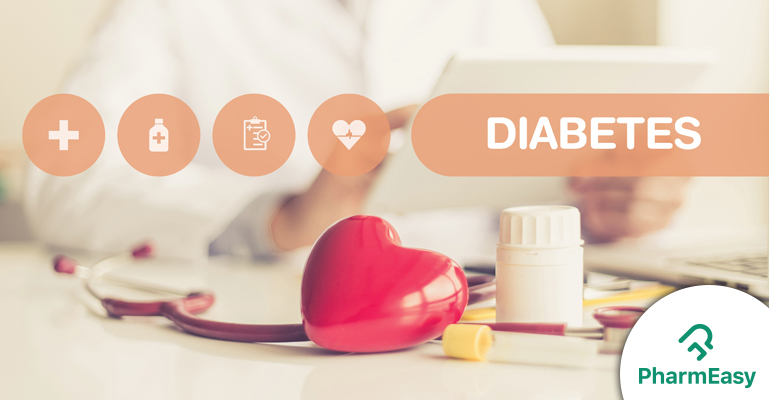Diabetes Insipidus VS Diabetes Mellitus: Everything You Must Know
By Dr. Nikita Toshi +2 more

Get,

to manage your symptom
Get your,


4 Cr+ families
benefitted

OTP sent to 9988776655



You’ve successfully subscribed to receive
doctor-approved tips on
Whatsapp

Get ready to feel your best.

Hi There,
Download the PharmEasy App now!!


Register to Avail the Offer
Send OTPBy continuing, you agree with our Privacy Policy and Terms and Conditions

Hi There,
Sign up on PharmEasy now!!
Trusted by 4 crore+ families

OTP sent to 9988776655



You have unlocked 25% off on medicines




Code: NU25
By Dr. Nikita Toshi +2 more
Diabetes can be classified into two categories: Diabetes insipidus and diabetes mellitus. Both have serious consequences, though they are entirely different from each other. Let’s take a look at both of them and understand the differences.
Table of Contents
Diabetes Insipidus is a rare disease. It is caused when there are problems related to ADH (Anti Diuretic Hormone). Someone with diabetes insipidus suffers from excessive urination. There is no increase in the blood glucose levels, unlike diabetes mellitus. A series of tests are needed to diagnose the condition. If left untreated, the condition can cause kidney damage and chronic kidney disease.

Due to excessive urination, the person feels an increased thirst leading to excessive fluid consumption. Patients are at risk of suffering from dehydration. It is of four types:
Diabetes mellitus is the more common form of diabetes. It causes elevated sugar levels in the blood. The body breaks down food into glucose that is the fuel for the cells to carry out regular metabolic processes. When the body cannot process this glucose efficiently, it leads to high sugar levels that have serious health complications like kidney failure, vision loss, and amputations.
Diabetes mellitus is of two types:
The symptoms of diabetes mellitus include increased thirst and hunger, excessive urination, frequent vaginal yeast infections, slow healing of cuts and scrapes, and tingling and numbness in the feet. The disease is treated by medications that control the sugar levels and by providing synthetic insulin in the body. A healthy diet, regular exercise, weight loss and timely administration of medication are the recommended course of treatment.
| Diabetes Insipidus | Diabetes Mellitus |
| Caused by problems in hypothalamus | Caused by problems in the pancreas |
| Caused by deficiency of ADH | Caused by a deficiency of insulin hormone |
| Glucose levels are not elevated | glucose levels are elevated |
| Urine doesn’t have glucose present | Urine has glucose present |
| Urine is much diluted. It has no odour | Urine of normal concentration |
| Excessive urination | Urination much lesser than in diabetes insipidus |
| No increase in blood cholesterol | Increase in blood cholesterol |
| Eating patterns do not change | Eating patterns change with excessive hunger |
| Negative results when tested for ketone bodies in urine | Positive results when tested for ketone bodies in urine |
Both, diabetes mellitus and diabetes insipidus need urgent medical intervention. Consult your doctor if you suffer from any of these symptoms.
Diabetes insipidus is quite rare compared to diabetes mellitus. Diabetes insipidus commonly seen post head injury , brain surgery and brain cancer.
Dr. M.G. Kartheeka, MBBS, MD(Pediatrics)
A diabetes diet plan includes healthy food items in moderate items during regular meal times. The food items included in this diet should be naturally rich in nutrients, and low in fat and calories.
The key elements that go into making a proper diet plan for diabetes are vegetables, fruits and whole grains. In fact, people with borderline diabetes or who have a family history should follow this diet as a part of a healthy meal plan.
Poorly controlled or uncontrolled diabetes insipidus may lead to dehydration and electrolyte imbalance and this might specifically be harmful if it happens during pregnancy. Keep a caution and visit your gynecologist for any associated symptoms
Dr. Ashish Bajaj, M.B.B.S., M.D. in Clinical Pharmacology and Toxicology
Diabetes may increase the chances of heart-related ailments and stroke by accelerating the development of hardened artillery or blocking them. Foods containing the following can work against your goal of having a proper, balanced diabetes meal plan:
Disclaimer: The information provided here is for educational/awareness purposes only and is not intended to be a substitute for medical treatment by a healthcare professional and should not be relied upon to diagnose or treat any medical condition. The reader should consult a registered medical practitioner to determine the appropriateness of the information and before consuming any medication. PharmEasy does not provide any guarantee or warranty (express or implied) regarding the accuracy, adequacy, completeness, legality, reliability or usefulness of the information; and disclaims any liability arising thereof.
Links and product recommendations in the information provided here are advertisements of third-party products available on the website. PharmEasy does not make any representation on the accuracy or suitability of such products/services. Advertisements do not influence the editorial decisions or content. The information in this blog is subject to change without notice. The authors and administrators reserve the right to modify, add, or remove content without notification. It is your responsibility to review this disclaimer regularly for any changes.

Leave your comment...
Comments